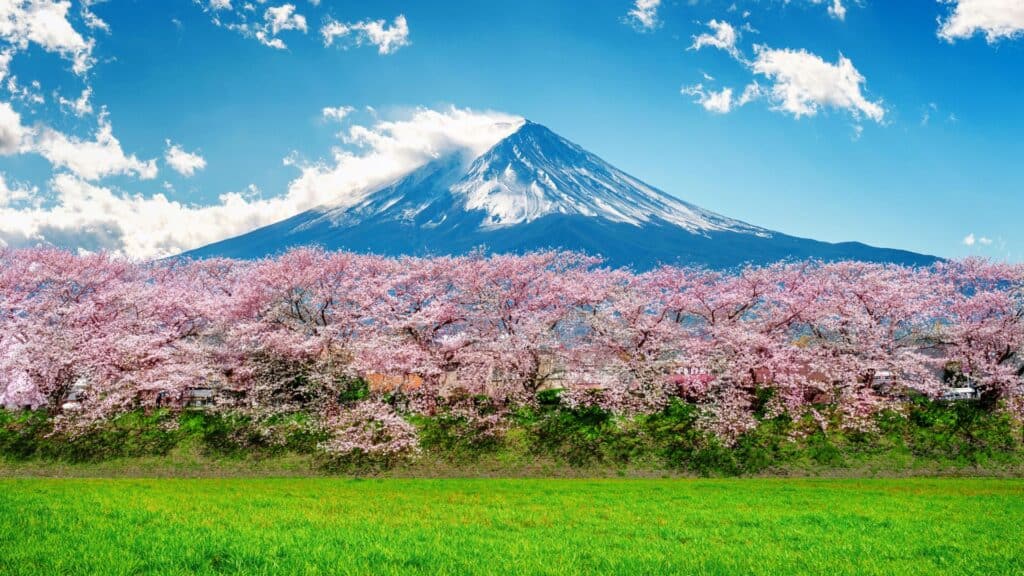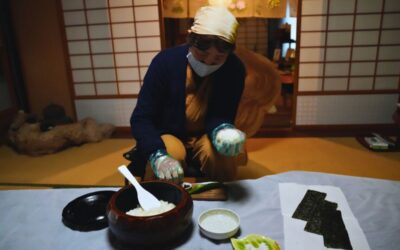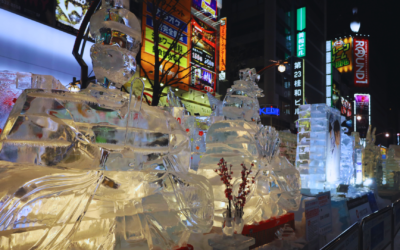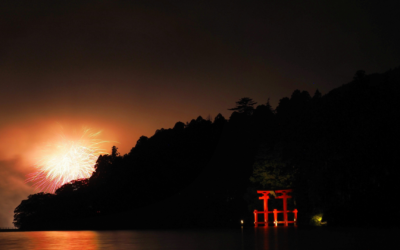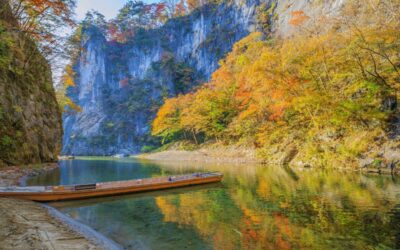Cherry blossoms in Japan aren’t just pretty flowers—they’re deeply tied to life’s big milestones, especially graduation and the start of a new school year. These delicate blooms perfectly capture the essence of spring, making them a beloved symbol across the country.
What Are Cherry Blossoms?
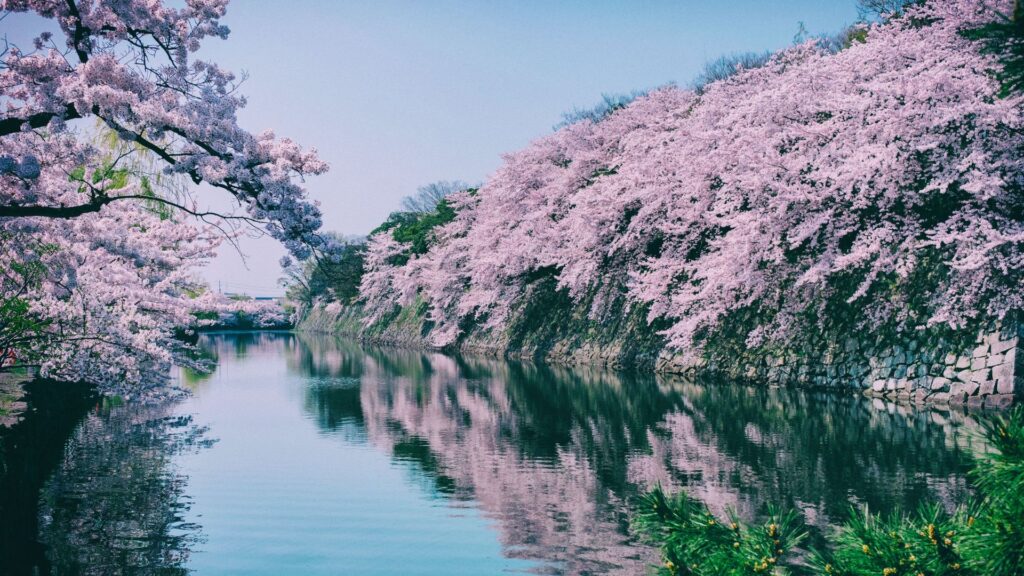
Japan is home to a stunning variety of cherry blossoms, with around 15 wild species and more than 300 cultivated types. The most famous is the Somei Yoshino, known for its pale pink petals, commonly found in parks, gardens, and streets.
Some cherry blossoms bloom earlier than others. The Kawazu-zakura, with its deep pink flowers, starts showing up in late February, while varieties like the Oshima-zakura, with larger blossoms, and the Miyama-zakura, which has smaller flowers, add to Japan’s vibrant springtime display.
Types of Cherry Blossoms

Various types of cherry blossoms bloom at different times, but most cherry blossoms in Tokyo reach their peak at the end of March or the beginning of April.
When that happens, the whole city comes alive. Streets, parks, and even cafes embrace the cherry blossom craze—think pink-themed decorations, limited-edition sakura-flavoured treats, and countless people taking photos under the trees.
This season isn’t just about flowers—it’s a cultural event. Cherry blossom festivals take over parks and castle grounds, drawing visitors from all over the world. These delicate blooms have inspired everything from traditional art and tattoos to poetry and anime, making them a huge part of Japanese aesthetics and storytelling.
Where Can Cherry Blossoms be Found?

The Somei Yoshino is Japan’s most popular cherry blossom variety, often found along riverbanks, castle moats, and school grounds, forming dreamy tunnels of pink and white. Their reflections on the water make for some of the most breathtaking springtime views.
For a richer pink hue and an early bloom, the Kawazu cherry tree—native to the Kawazu region of the southern Izu Peninsula—offers a vibrant display from late February to early March. The Kawazu Cherry Blossom Festival is a must-see, drawing about a million visitors each year.
If you can’t make it during spring, don’t worry! Aichi Prefecture is home to the shikizakura, or “four seasons cherry blossoms,” which bloom twice a year. In autumn, they create a surreal contrast, with soft pink flowers set against fiery red and orange fall foliage.
The Meaning and Symbolism of Cherry Blossoms

Cherry blossoms are more than just beautiful—they carry deep symbolism in Japanese culture. From delicate ukiyo-e woodblock prints to intricate folding screen designs, they’ve been a favourite artistic motif for centuries. You’ll also find them in manga, anime, and even everyday objects like bento boxes and stationery.
One of the reasons cherry blossoms are so beloved is their fleeting nature. They bloom spectacularly for a short time before scattering like soft pink snow. This impermanence ties into the Japanese concept of “mono no aware”—a deep appreciation for the beauty of things that don’t last forever.
Zen monk Ikkyu once captured this sentiment perfectly:
“If you cut down a cherry tree, you won’t find flowers inside it. But when the spring wind blows, countless flowers bloom.”
Since they bloom in late March and early April, cherry blossoms also mark life’s transitions—like the end of one chapter and the start of another. For many, they bring back nostalgic memories of school days and fresh starts.
Hanami: The Art of Cherry Blossom Viewing

In Japan, hanami (cherry blossom viewing) is a beloved tradition. People gather in parks with friends, family, or colleagues, laying out picnic blankets under the blossoms while enjoying food, drinks, and good company. Some stay well into the evening for yozakura, nighttime cherry blossom viewing, when the trees are beautifully illuminated.
Every year, cherry blossom forecasts are eagerly anticipated, with people planning their hanami parties months in advance.
When and Where to Catch Cherry Blossoms in Japan

Since Japan stretches across different climate zones, cherry blossom season lasts around four months, varying by region:
- Okinawa (Southernmost Islands) – Blooms start in mid-January, peaking in early February.
- Kyushu (Fukuoka, Kagoshima, Kumamoto) – Blossoms appear from late March to early April.
- Kansai (Osaka, Kyoto, Nara) – The season runs from March to April.
- Tokyo & Yokohama – Blooms begin in late March, reaching full bloom in early April.
- Tohoku (Northern Honshu, including Hirosaki) – Peak season is in April, with full bloom around the last week of the month.
- Hokkaido (Sapporo, Hakodate) – The final wave of cherry blossoms blooms in early May.
Cherry Blossom Festivals in Japan
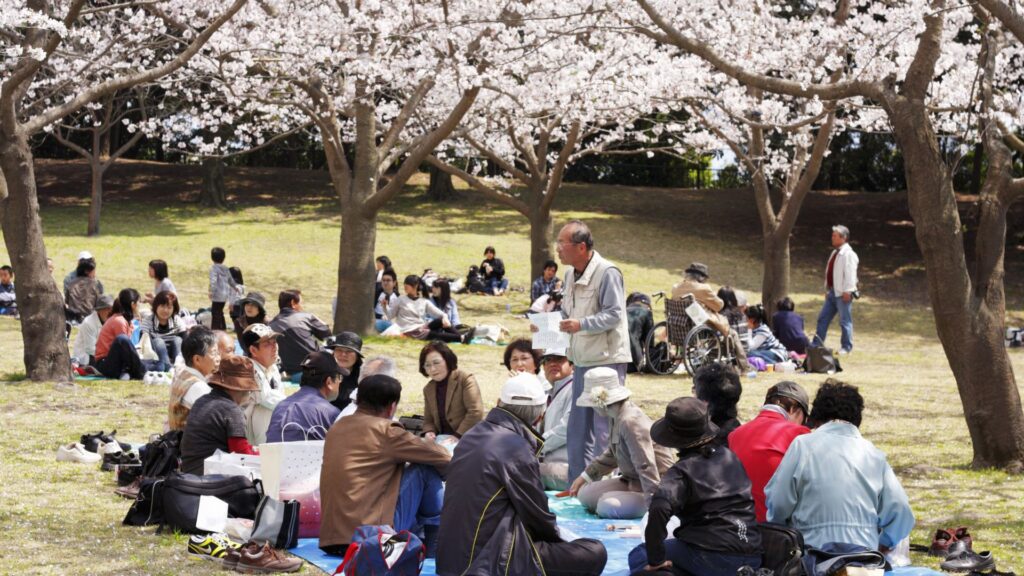
Spring in Japan wouldn’t be complete without hanami—the centuries-old tradition of cherry blossom viewing. Across the country, people gather in parks and public spaces to celebrate the arrival of these iconic blooms. From casual picnics with friends to grand corporate events, hanami is all about enjoying the fleeting beauty of cherry blossoms with good food, drinks, and laughter.
A classic hanami picnic isn’t your typical blanket-on-the-grass setup. Instead, groups sit on bright blue plastic sheets under the trees, indulging in homemade bento boxes, sakura mochi, and seasonal drinks. Some spots get so crowded that people stake out their space hours—or even days—in advance!
As night falls, many festivals feature yozakura, or nighttime cherry blossom viewings, where the trees are illuminated, creating a magical, dreamlike atmosphere. Historic locations, like castle grounds, become especially popular during this time, as the contrast between the delicate pink flowers and ancient architecture makes for stunning sights.
One of the biggest celebrations is the Hirosaki Cherry Blossom Festival in Aomori, which attracts over two million visitors every year. In Tokyo, the Nakameguro River transforms into a fairytale scene with lantern-lit cherry blossoms reflecting on the water, making for one of the most photogenic spots in the city.
Top Cherry Blossom Spots in Japan
Discovering the best places to see cherry blossoms in Japan is a magical journey through iconic landscapes and historical sites. Here are the top destinations for cherry blossom enthusiasts:
1. Meguro River, Tokyo

📅 Best Time: Late March–Early April
🌸 Cherry Trees: ~800
This trendy Tokyo hotspot features a 3.8 km stretch of cherry trees along the river, creating a gorgeous pink tunnel. Stylish cafes and pop-up stalls serve strawberry cocktails and sakura-themed drinks, making it a perfect spot for a scenic stroll.
2. Osaka Castle, Osaka Prefecture
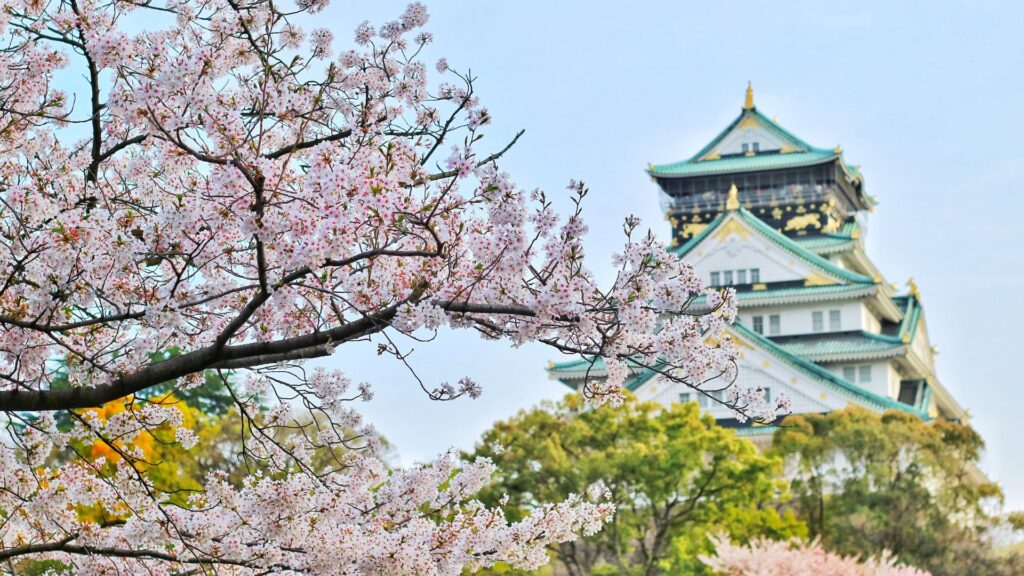
📅 Best Time: Late March–Mid-April
🌸 Cherry Trees: ~3,000
One of Japan’s “100 Best Cherry Blossom Viewing Spots,” Osaka Castle’s Nishinomaru Garden is particularly famous for its nighttime illuminations, with 300 cherry trees beautifully framing the historic castle.
3. Shinjuku Gyoen, Tokyo

📅 Best Time: Late March–Late April
🌸 Cherry Trees: ~1,000
A peaceful retreat in the middle of bustling Tokyo, Shinjuku Gyoen boasts 65 different cherry tree varieties, meaning you can enjoy an extended cherry blossom season here.
4. Himeji Castle, Hyogo Prefecture

📅 Best Time: Early April
🌸 Cherry Trees: ~1,000
The stunning contrast between Himeji Castle’s pristine white walls and the soft pink cherry blossoms makes this one of the most iconic hanami spots in Japan. The weeping cherry trees in Nishi-no-Maru Garden add an extra layer of charm.
5. Daigoji Temple, Kyoto Prefecture
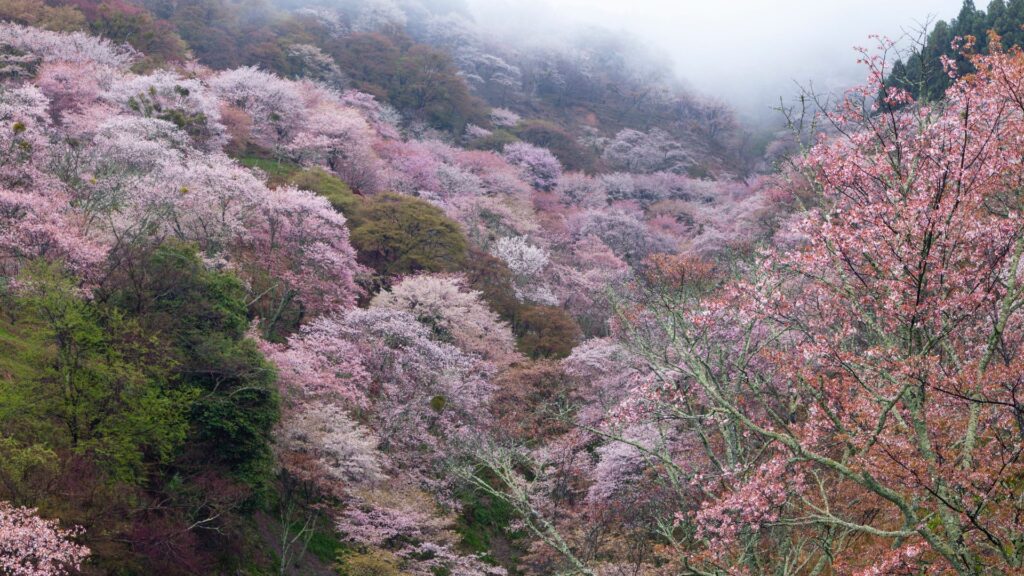
📅 Best Time: Late March–Early April
🌸 Cherry Trees: ~1,000
This UNESCO-listed temple is famous for Toyotomi Hideyoshi’s legendary hanami party and features a beautiful mix of cherry tree species, including weeping sakura and Someiyoshino.
6. Yoshinoyama, Nara Prefecture

📅 Best Time: Early–Mid-April
🌸 Cherry Trees: ~30,000
If you want a cherry blossom overload, this World Heritage site is the place to be. The blooms start at the base of the mountain and gradually move upwards, offering one of the longest viewing periods in Japan.
7. Kintai Bridge, Yamaguchi Prefecture

📅 Best Time: Late March–Early April
🌸 Cherry Trees: ~3,000
This historic wooden bridge is surrounded by cherry blossoms, creating a storybook-like landscape. Visit at night to see the trees beautifully illuminated.
8. Kiyomizu Temple, Kyoto Prefecture

📅 Best Time: Early–Late April
🌸 Cherry Trees: ~1,000
From Kiyomizu Temple’s famous wooden stage, you can take in panoramic views of cherry blossoms across Kyoto. At night, the illuminated trees create a magical, almost surreal atmosphere.
9. Hirosaki Park, Aomori Prefecture

📅 Best Time: Late April
🌸 Cherry Trees: ~2,600
Voted one of Japan’s top three nighttime cherry blossom spots, Hirosaki Park features a breathtaking combination of castle ruins, ancient stone walls, and thousands of cherry blossoms reflecting in the moat.
10. Shiraishigawa Tsutsumi, Miyagi Prefecture
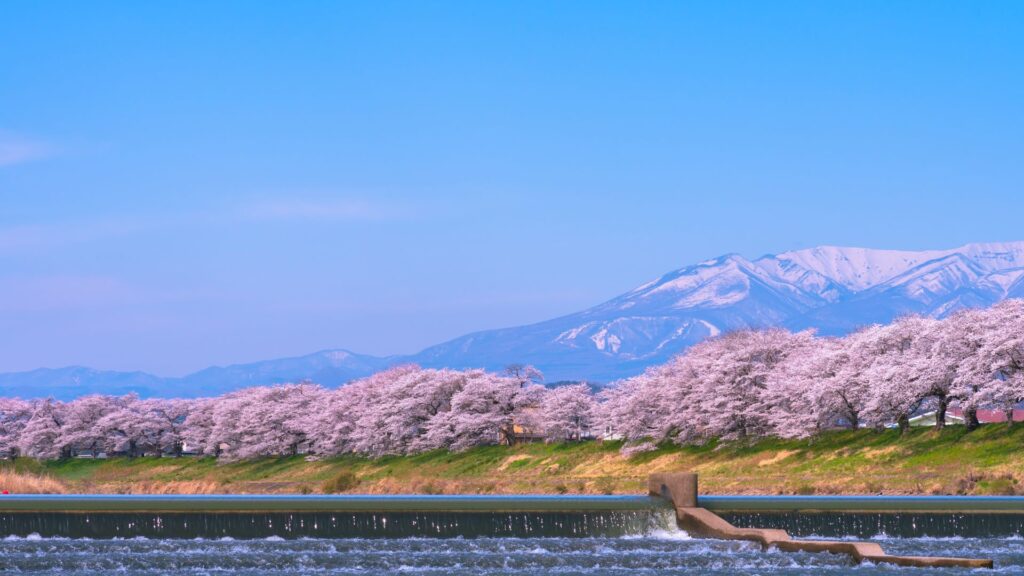
📅 Best Time: Early–Mid-April
🌸 Cherry Trees: ~1,200
This 8 km-long row of cherry trees creates a pink canopy that stretches as far as the eye can see. For a special experience, hop on a traditional yakatabune boat to view the blossoms from the water.
11. Takato Joshi Park, Nagano Prefecture

📅 Best Time: Early–Mid-April
🌸 Cherry Trees: ~1,500
Takato Joshi Park is famous for its unique Takato Okohigan cherry trees, which have a deeper pink hue than the usual Someiyoshino.
12. Niikurayama Sengen Park, Yamanashi Prefecture

📅 Best Time: Early–Mid-April
🌸 Cherry Trees: ~650
If you’re after the ultimate Mount Fuji + cherry blossom photo, this is the spot. Climb 398 steps for an unforgettable panoramic view of sakura framing Japan’s most famous mountain.
13. Takada Joshi Park, Niigata Prefecture

📅 Best Time: Early–Mid-April
🌸 Cherry Trees: ~4,000
Known as one of Japan’s top three night cherry blossom spots, this park’s 3,000 lanterns and castle reflections make for a breathtaking hanami experience.
14. Goryokaku Park, Hokkaido

📅 Best Time: Late April–Early May
🌸 Cherry Trees: ~1,600
This star-shaped fortress becomes a pink wonderland in late April, with boat rentals available for a unique sakura-on-the-water experience.
15. Ninna-ji Temple, Kyoto
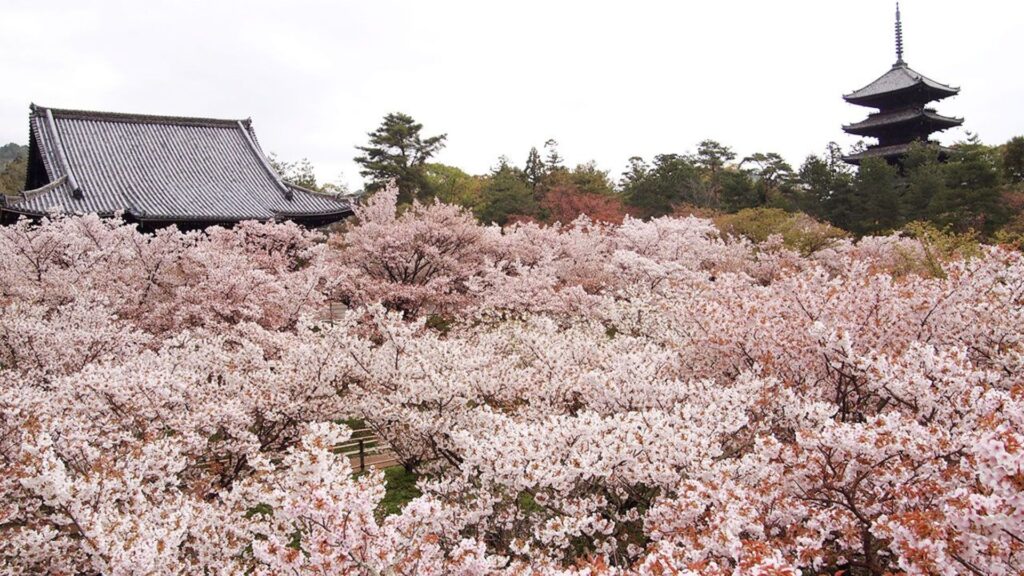
📅 Best Time: Late March–Early April
🌸 Cherry Trees: ~1,200
One of Tokyo’s most popular hanami spots, Ueno Park has been a cherry blossom hub since the Edo period. Expect a lively festival atmosphere with street food, paper lanterns, and crowds soaking in the blossoms.
16. Ueno Onshi Park, Tokyo
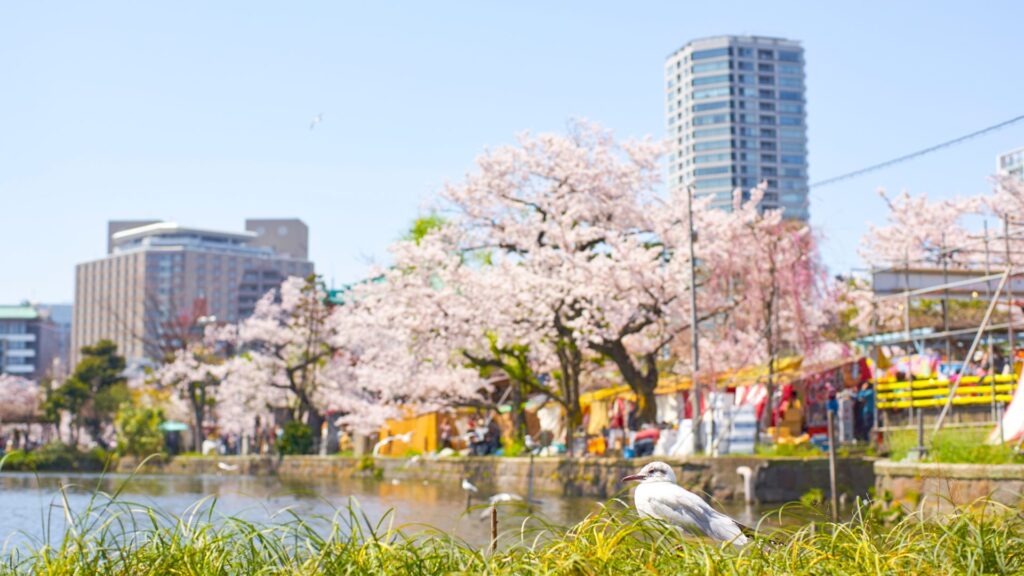
📅 Best Time: Late March–Early April
🌸 Cherry Trees: ~1,200
One of Tokyo’s most famous and lively hanami spots, Ueno Onshi Park has been a cherry blossom hotspot since the Edo period. With over 1,200 cherry trees, it becomes a vibrant festival ground in spring, featuring food stalls, street performers, and illuminated paper lanterns at night. The park’s central location and festive atmosphere make it a top choice for both locals and tourists looking to experience hanami in full swing.
17. Sumida River, Tokyo

📅 Best Time: Late March–Early April
🌸 Cherry Trees: ~1,000
A classic cherry blossom viewing spot near Asakusa and Tokyo Skytree, the Sumida River’s riverside walkways are lined with sakura trees. One of the best ways to experience this area is on a yakata-bune (traditional Japanese houseboat), offering stunning river views with cherry blossoms reflecting on the water.
18. Rikugien, Tokyo

📅 Best Time: Late March–Early April
🌸 Cherry Trees: Several majestic weeping cherries
Rikugien, one of Tokyo’s most famous traditional gardens, is best known for its enormous weeping cherry tree, which looks like a waterfall of pink petals when in full bloom. The trees are illuminated at night, adding a dreamy, otherworldly feel to the experience.
19. Kasumigajo Park, Fukushima Prefecture
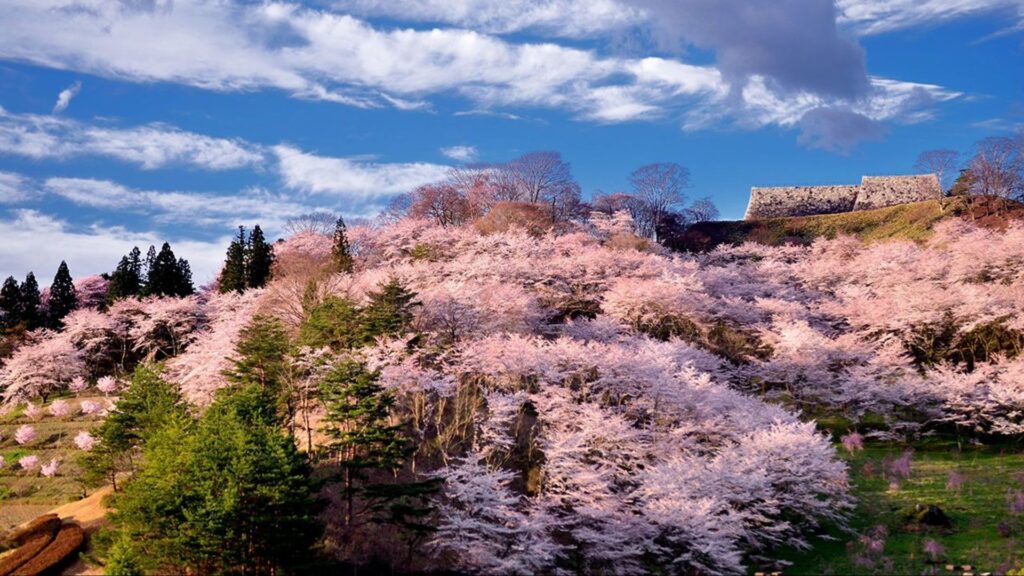
📅 Best Time: Early–Mid-April
🌸 Cherry Trees: ~2,500
Nicknamed “the castle in the mist”, Kasumigajo Park is renowned for its ethereal cherry blossom scenery. The ruins of Nihonmatsu Castle provide a historic and dramatic backdrop, especially when illuminated at night. This park is also ranked among Japan’s 100 best cherry blossom spots.
20. Heian Jingu Shrine, Kyoto
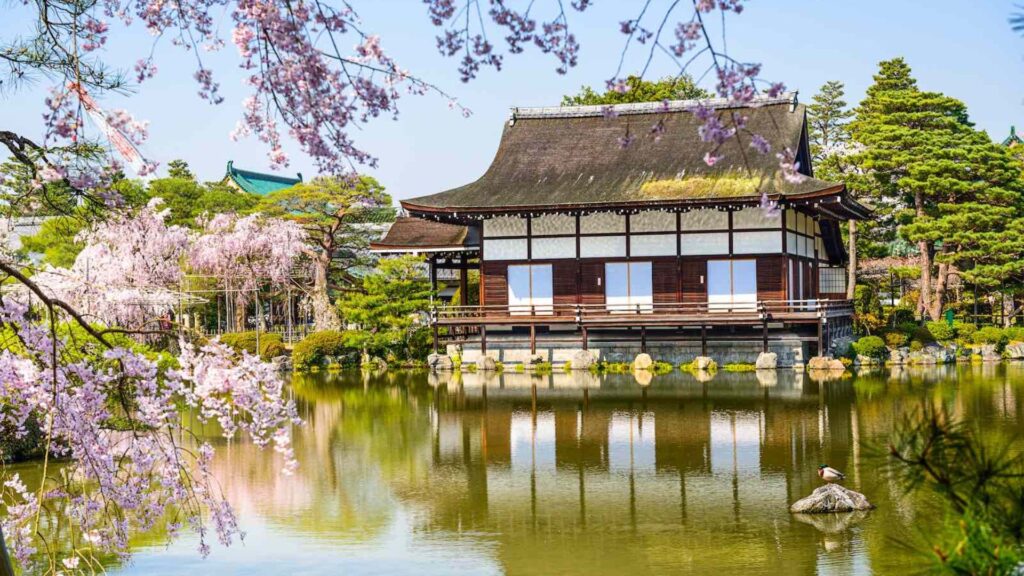
📅 Best Time: Late March–Early April
🌸 Cherry Trees: ~300
One of Kyoto’s most underrated cherry blossom spots, Heian Jingu Shrine features beautiful weeping cherry trees that bloom in soft shades of pink and crimson. The contrast of the vibrant red torii gates, historic architecture, and pink blossoms creates a stunningly photogenic scene, especially in the shrine’s garden.
The Magic of Cherry Blossoms in Japan 🌸✨
Cherry blossoms in Japan are more than just flowers—they’re a symbol of beauty, renewal, and the fleeting nature of life. Whether you’re walking beneath a pink canopy in Tokyo, taking in the view of Mount Fuji framed by blossoms, or enjoying a late-season bloom in Hokkaido, every hanami experience is special.
So, have you ever experienced cherry blossom season in Japan? If not, where would you love to go first? Let me know! 😊🌸
Find out all about the different flowers in Japan you can enjoy throughout the year here.

